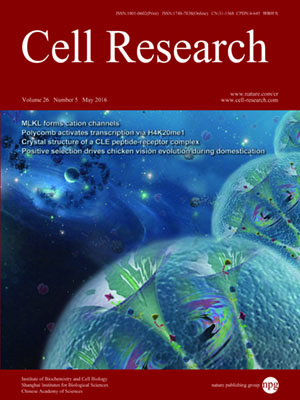
Volume 26, No 5, May 2016
ISSN: 1001-0602
EISSN: 1748-7838 2018
impact factor 17.848*
(Clarivate Analytics, 2019)
Volume 26 Issue 5, May 2016: 629-632 | Open Access
LETTERS TO THE EDITOR
YEATS2 is a selective histone crotonylation reader
Dan Zhao1,2, Haipeng Guan1, Shuai Zhao1, Wenyi Mi3, Hong Wen3, Yuanyuan Li1,4, Yingming Zhao5, C David Allis6, Xiaobing Shi3,7 and Haitao Li1,8
1MOE Key Laboratory of Protein Sciences, Beijing Innovation Center for Structural Biology, Department of Basic Medical Sciences, School of Medicine, Tsinghua University, Beijing 100084, China
2College of Life Sciences, Peking University, Beijing 100871, China
3Department of Epigenetics and Molecular Carcinogenesis, Center for Cancer Epigenetics, The University of Texas MD Anderson Cancer Center, Houston, TX 77030, USA
4Tsinghua-Peking Center for Life Sciences, Tsinghua University, Beijing 100084, China
5Ben May Department of Cancer Research, The University of Chicago, Chicago, IL 60637, USA
6Laboratory of Chromatin Biology and Epigenetics, The Rockefeller University, New York, NY 10065, USA
7Genes and Development and Molecular Carcinogenesis Graduate Programs, The University of Texas Graduate School of Biomedical Sciences, Houston, TX 77030, USA
8Collaborative Innovation Center for Biotherapy, West China Hospital, Sichuan University, Chengdu 610041, China
Correspondence: Haitao Li, E-mail: lht@tsinghua.edu.cn; Xiaobing Shi,(xbshi@mdanderson.org)
Histone lysine crotonylation (Kcr) is a recently identified non-acetyl acylation conserved from yeast to human. We have previously shown that histone Kcr marked active chromatin and was enriched at promoter and enhancer regions1. Different from the histone lysine acetylation (Kac), histone Kcr preferentially marks “escapee genes” during post-meiotic gene inactivation, suggesting a unique regulatory mechanism centered on Kcr independent of Kac2. Nevertheless, in contrast to the histone Kac readers that are well documented, selective readers for histone Kcr remain unknown. Although a few bromodomain-containing proteins (e.g., TAF1) were shown to recognize Kcr, their binding affinities are much compromised as compared to Kac binding3.
10.1038/cr.2016.49
FULL TEXT | PDF
Browse 2369


